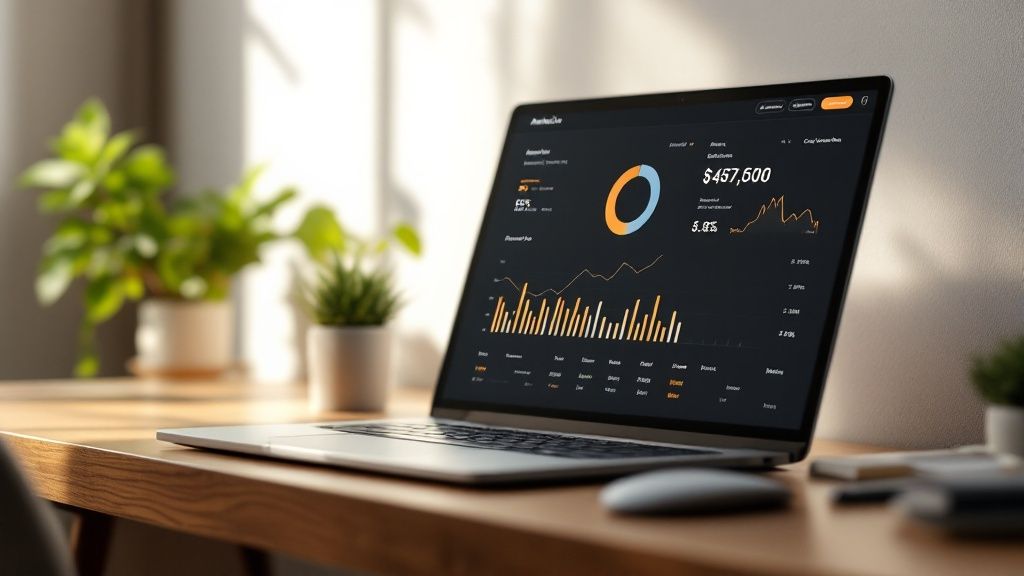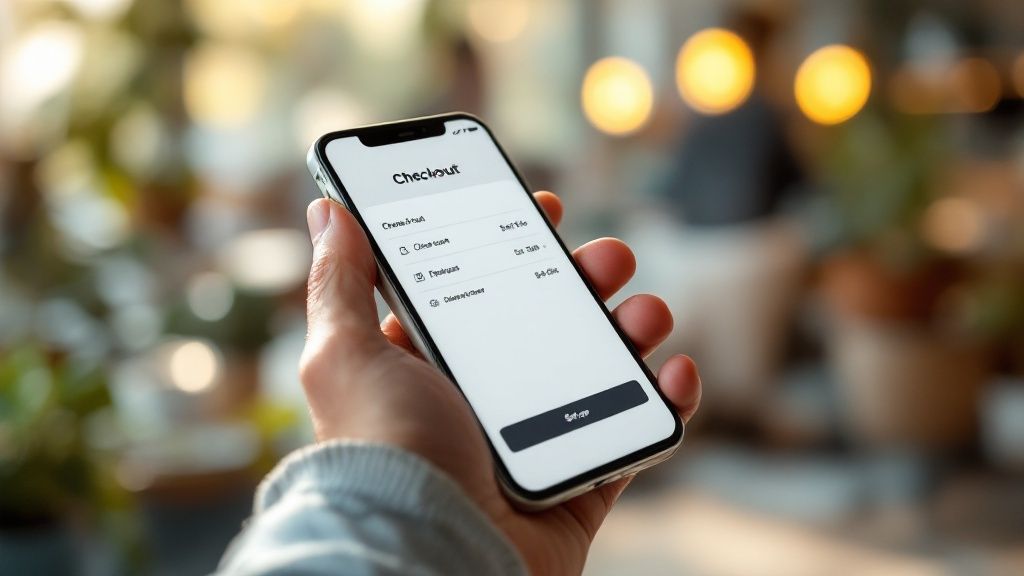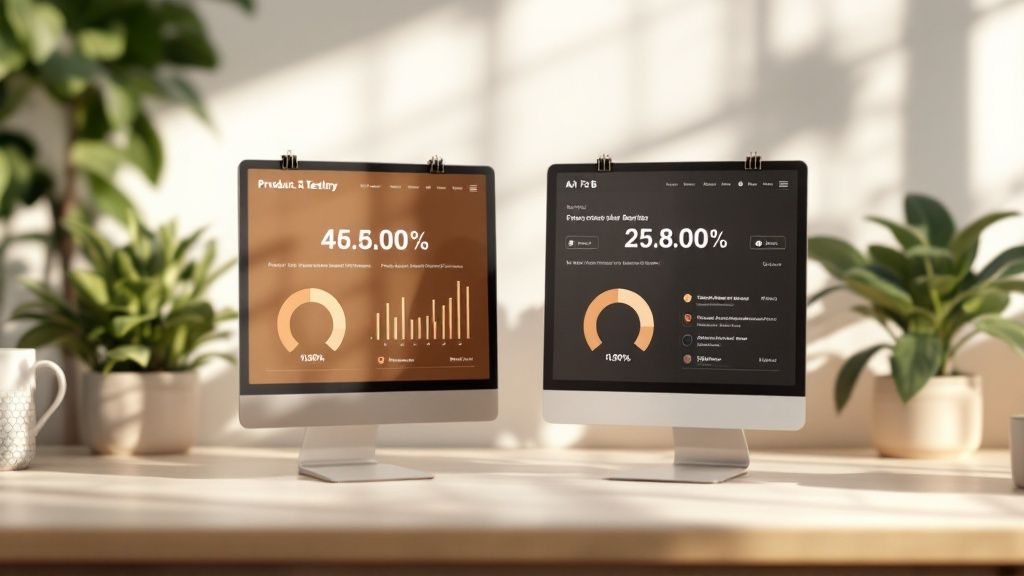Ecommerce Conversion Rate Optimization: A Complete Guide That Actually Works
January 17, 2025

Understanding What Really Moves the Conversion Needle

Successful ecommerce conversion optimization requires a deep understanding of what actually drives buying decisions. Rather than chasing quick fixes, businesses need to carefully examine the specific factors that influence their customers' purchasing behavior. This section explores the fundamental principles that lead to meaningful conversion improvements and provides a practical framework for setting realistic goals.
Benchmarking Against Relevant Industry Standards
To optimize effectively, you first need to understand how your conversion rates compare to similar businesses in your industry. For example, sporting goods retailers typically see conversion rates around 2.35%, while arts and crafts businesses often achieve rates near 4.07%. These variations highlight why comparisons must be made within your specific sector – comparing your sporting goods store to an arts and crafts business won't provide meaningful insights.
Keep in mind that average rates are just a starting point, not the end goal. Instead of simply aiming to match industry averages, use them as a baseline to identify specific opportunities for improvement within your business. This leads to an important question: which metrics matter most for your unique situation?
Identifying the Metrics That Matter Most
While overall conversion rate provides valuable information, fixating on this single number can be misleading. Different business models require different metrics for success. A store selling luxury items might have a lower conversion rate but still be highly profitable due to high average order values. Meanwhile, a business selling low-cost items needs higher conversion volumes to reach similar revenue goals.
This means you need to identify the specific metrics that align with your business model. Beyond conversion rate, examine metrics like average order value, customer lifetime value, and cart abandonment rate. These measurements offer detailed insights into customer behavior and can reveal specific areas needing improvement. For example, if you notice high cart abandonment, it may signal issues with your checkout process that need fixing.
Adapting to the Ever-Shifting Ecommerce Landscape
Customer shopping habits continue to change as technology advances and new trends emerge. Mobile shopping growth, increasing demand for personalized experiences, and expectations for quick checkout have reshaped how people shop online. This means conversion optimization must be an ongoing process of testing and refinement rather than a one-time fix.
Recent shifts in consumer trust illustrate this need for continuous adaptation. As shoppers become more concerned about online security and privacy, businesses must focus on building trust through transparency. This includes clearly displaying security certificates, offering trusted payment options, and providing detailed product information. Understanding and responding to these changing customer needs helps businesses maintain healthy conversion rates over time.
Transforming Your Store Through Strategic Video Content

Once you've established your key metrics and benchmarks, video content becomes the next vital element for improving your ecommerce conversion rates. However, success requires more than simply adding random videos to your product pages. The real impact comes from creating videos that connect with your audience and guide them toward making a purchase.
Why Video Is a Game-Changer for Ecommerce
Video brings products to life in ways that photos and text descriptions cannot match. When customers can see fabric textures moving, hear product sounds, and watch items being used in real situations, they gain confidence in their purchase decisions. The proof is in the numbers – adding video to landing pages has been shown to boost conversions by up to 86%. This makes video an essential tool for building trust and addressing common concerns that stop people from buying online.
Crafting Compelling Videos That Convert
The key is creating videos that speak directly to your target customers' needs and interests. Basic product demos are just the starting point. Consider developing:
- Lifestyle videos: Show real people using your products in everyday situations to help customers envision the benefits
- Testimonial videos: Share authentic customer stories and experiences to build credibility
- Explainer videos: Break down complex features into clear, helpful demonstrations
- Behind-the-scenes videos: Connect with customers by showing the people and values behind your brand
Optimizing Video Placement and Platform
Where you place your videos matters as much as what's in them. Think about your customers' journey – product page videos should focus on features and benefits, while social media content might highlight lifestyle uses. Different platforms also require different approaches. Quick, engaging clips work best on social media, while your website can host more detailed product tutorials and demonstrations.
For example, a catchy Instagram Reel showing your product in action can attract new audiences, while an in-depth YouTube tutorial can answer specific questions from interested buyers. By matching your video content to each platform's strengths, you'll see better results.
Measuring the Impact of Your Video Strategy
Track key metrics like watch time, engagement rates, and click-throughs to understand which videos resonate most with viewers. Use this data to guide future content creation. For instance, if lifestyle videos consistently drive more engagement than basic product demos, invest in creating more lifestyle content. Regular analysis helps you continuously improve your video strategy and boost conversion rates over time.
Making Personalization Work Without Breaking the Bank

Creating personalized customer experiences doesn't require expensive, complex systems. Smart ecommerce businesses can boost conversion rates through simple, targeted tactics that deliver relevant messages to the right customers at optimal times. The key is being strategic about how you implement personalization.
Understanding the Power of Personalized Experiences
When customers feel understood and valued, they're more likely to make a purchase. For example, data shows that personalizing call-to-action buttons based on visitor interests improves click-through rates by 42%. This direct impact on conversions demonstrates why making content relevant to each visitor is so important for ecommerce success.
Segmenting Your Audience for Targeted Impact
The foundation of effective personalization is audience segmentation – grouping customers based on shared traits like demographics, browsing habits, or purchase history. For instance, you might create separate segments for frequent athletic shoe buyers versus hiking gear browsers. This allows you to tailor product suggestions and promotions specifically for each group's interests and needs.
Leveraging Behavioral Targeting for Real-Time Personalization
Taking personalization further, you can adjust content based on visitors' real-time actions on your site. When someone spends time viewing certain product categories, you can automatically show related items or targeted offers. This responsive approach helps guide interested shoppers toward completing their purchase. You might be interested in: How to master personalization in ecommerce.
Implementing AI-Powered Recommendations Without the High Cost
Many affordable tools now offer AI-powered product suggestions without requiring major investment. These solutions analyze customer data to recommend relevant items, helping increase cross-sells and upsells. Studies show AI-driven personalization can boost conversion rates up to 30% by showing each visitor the most appealing options.
Prioritizing User Privacy While Personalizing
As you collect data to personalize experiences, maintaining customer trust is essential. Be open about your data practices and give visitors clear control over their information. Make privacy options easily accessible and ensure you comply with regulations. When customers feel their data is respected, they're more comfortable engaging with personalized content. This builds loyal relationships that drive long-term conversion growth as privacy awareness continues rising.
Building a Lightning-Fast Shopping Experience

When shopping online, customers expect a quick and smooth experience from start to finish. Fast loading times are essential, but equally important is eliminating friction points throughout the entire shopping journey. Slow performance and complex navigation directly impact sales and customer satisfaction.
Optimizing Page Load Speed for Improved Conversions
Research shows that just one extra second of load time can reduce conversions by 7%. To maximize sales, aim to get your pages loading in under two seconds. Real-world examples demonstrate the impact of speed – when FSAstore.com simplified their web funnel and focused on performance, they saw average revenue per visitor increase by 53.8%. This shows how faster experiences directly boost revenue.
Streamlining the Checkout Process
Many customers abandon their carts due to complicated checkout flows. Simple changes like offering guest checkout options and showing shipping costs early can significantly reduce friction points. Including popular payment methods like PayPal and Apple Pay gives customers flexibility in how they pay, making them more likely to complete their purchase.
Enhancing the Mobile Shopping Experience
Mobile commerce continues to grow rapidly, making mobile optimization critical for success. Your site needs to work flawlessly across all screen sizes. Focus on creating a smooth mobile browsing experience with easy navigation and mobile-specific promotions to capture this expanding customer segment.
Identifying and Addressing Performance Bottlenecks
Finding specific performance issues requires data. Tools like Google PageSpeed Insights can pinpoint technical problems like oversized images or slow server response times. Regular A/B testing helps identify which design elements connect best with customers. Making iterative improvements based on real data creates an experience that drives sales and builds loyalty. The key is consistently monitoring and optimizing for both speed and usability.
Mastering Industry-Specific Conversion Tactics
Every industry requires its own unique approach to conversion rate optimization. Just like fishing with different bait for different fish, the tactics that work well in one sector may fall flat in another. Success depends on understanding the specific needs and behaviors of your target customers.
Decoding the Fashion and Apparel Landscape
Fashion ecommerce sites typically see conversion rates between 1.01% and 2.20%. Since fashion shoppers rely heavily on visuals to make buying decisions, high-quality product photography and videos are essential. Clear size guides and authentic customer reviews with photos help recreate the in-store try-on experience online. For instance, showing how garments look on different body types can give shoppers the confidence to click "buy."
Navigating the Health and Wellness Sector
The health and wellness industry sees higher average conversion rates of 1.87% to 4.20%, but these customers need extensive proof before purchasing. Detailed ingredient lists, safety certifications, and clinical study results help build the trust that drives sales. Expert endorsements from healthcare professionals can provide the credibility these shoppers seek before trying a new supplement or wellness product.
Targeting Specific Customer Behaviors
Beyond broad industry trends, understanding individual customer segments is crucial. A luxury fashion shopper has very different needs and motivations than someone hunting for budget basics. This means carefully segmenting your audience and customizing everything from promotional messaging to site design for each group. The more precisely you can match your approach to specific customer preferences, the better your results.
Adapting Strategies for Optimal Results
Success requires constant testing and refinement based on real data. By running A/B tests on website elements like product descriptions, calls-to-action, promotional offers and checkout flows, you can identify what resonates with your specific audience. Regular analysis of test results helps you optimize your approach over time. Stay responsive to changing customer behavior and market conditions.
Implementing Winning Tactics Across Industries
While each industry has unique requirements, some core principles apply universally. Fast page loads, intuitive navigation, and smooth checkout processes matter for every ecommerce site. Build these fundamental elements first, then layer on industry-specific strategies. This creates a solid foundation for growth, like constructing a house before adding custom design features. When you combine proven best practices with tactics tailored to your market, you create a formula for consistently strong conversions.
Scaling Your Success Through Data-Driven Decisions
Making smart decisions based on data is essential for growing your ecommerce business. Once you've mastered the basics like video content, personalization, and site speed, it's time to use data strategically to improve your results. Let's explore how to move from guesswork to a scientific approach.
A/B Testing: Your Secret Weapon for Optimization
A/B testing (split testing) helps you make improvements based on real user behavior rather than assumptions. This method involves showing two versions of a webpage element to different visitors and measuring which performs better. For example, you might test two product page headlines – one focused on benefits and another on features. By sending equal traffic to both versions, you can see which headline drives more sales. These insights allow you to confidently implement winning changes across your site.
Implementing Analytics for Actionable Insights
Data only becomes valuable when you analyze it properly. Tools like Google Analytics help you understand what your A/B tests and other data are telling you about customer behavior. You can track key metrics like bounce rates, time on page, and conversion paths to spot where visitors get stuck or leave your site. This detailed view of how people interact with your store guides smart optimization decisions.
Scaling Winning Tactics Across Your Operation
After identifying what works through testing and analysis, the next step is implementing those successful elements throughout your store. This could mean using proven headlines on all product pages or fixing checkout friction points identified through cart abandonment data. However, take care to adapt winning tactics for different product types and customer segments rather than applying them blindly.
Building a Culture of Testing and Optimization
Long-term ecommerce success requires making testing and optimization part of your company culture. Encourage your team to question assumptions, propose new ideas, and use data to validate their theories. Like tuning an instrument, small ongoing adjustments lead to major improvements over time. This continuous cycle of testing and refinement helps your business stay competitive.
Measuring Success: Defining Your Key Metrics
To scale your optimization efforts effectively, you need clear success metrics. While overall conversion rate matters, also track metrics like average order value, customer lifetime value, and cart abandonment. This gives you a complete view of performance and highlights new optimization opportunities. Learn more in our guide to How to master ecommerce conversion rate optimization. Let the data guide your decisions as you work to improve results.
Ready to improve your checkout process and boost sales? Checkout Links helps Shopify merchants create custom shopping links that make buying easier. See how simple it is to optimize your checkout experience.
 Checkout Links
Checkout Links



